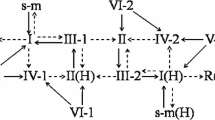Abstract
It reveals some equivalences between automata based on complete residuated lattice-valued logic (calledl valued automata) and the truth-value lattice of the underlying logic (i.e. residuated lattice). In particular, it demonstrates several basic equivalent characterizations on the retrievability ofl valued automata. Finally, the connections of the homomorphisms between twol valued automata to continuous mappings and open mappings are clarified. So this paper establishes further the more profound fuzzy automata theory.
Similar content being viewed by others
References
Hopcroft, J. E., Ullman, J. D., Introduction to Automata Theory, Languages, and Computation, New York: Addison-Wesley, 1979, 13–223.
Alon, N., Dewdney, A., Ott, T., Efficient simulation of finite automata by neural nets, J. Assoc. Comput. Mach., 1991, 38(2): 498–514.
Shen, E. S., Model-theoretic logic and theoretical computer science, Advances in Mathematics (in Chinese), 1996, 25(3): 193–202.
Wee, W. G., On generalization of adaptive algorithm and application of the fuzzy sets concept to pattern classification, Ph.D. Thesis, Purdue University, June, 1967.
Malik, D. S., Mordeson, J. N., Fuzzy Discrete Structures, New York: Physica-Verlag, 2000, 139–246.
Omlin, C. W., Thornber, K. K., Giles, C. L., Fuzzy Finite-state Automata Can Be Deterministically Encoded into Recurrent Neural Networks, IEEE Trans. Fuzzy Syst., 1998, 6(1): 76–89.
Holcombe, W. M. L., Algebraic Automata Theory, New York: Cambridge University Press, 1982.
Bavel, Z., Introduction to the Theory of Automata, Virginia: Reston Publishing Company, Inc., 1983.
Qiu, D. W., Automata theory based on complete residuated lattice-valued logic, Science in China, Ser. F, 2001, 44(6): 419–429.
Wang, S. Q., Lu, J. B., The ultraproduct basic theorems of lattice-valued models, Chinese Science Bulletin, 1981, 26(2): 71–74.
Wang, S. Q., Two applications of constant constructive method in lattice-valued models theory, Chinese Science Bulletin, 1981, 26(3): 129–130.
Wang, S. Q., Omitting types theorem in lattice-valued models theory, Acta Mathematica Sinica (in Chinese), 1982, 25(2): 202–207.
Shen, F. X., Elementary entension and elementary chain of lattice-valued models, Chinese Science Bulletin, 1982, 27(5): 264–266.
Wang, G. J., Theory of L-Fuzzy Topological Spaces (in Chinese), Xi’an: Shaanxi Normal University Press, 1988.
Ying, M. S., Some of cover-style compactness in fuzzy topology, Acta Mathematica Sinica (in Chinese), 1994, 37(6): 852–856.
Qiu, D. W., On cover-style fuzzy compactness (in chinese), Journal of Zhongshan University, 1998, 37(3): 46–49.
Pavelka, J., On fuzzy logic I, II, III, Zeitschr f math Logik und Grundlagen d Math, 1979, 25: 45–52; 119–134; 447–464.
Wang, G. J., Non-classical Mathematical Logics and Approximate Reasoning, Beijing: Science Press, 2000, 207–274.
Ying, M. S., Automata theory based on quantum logic (I) (II), Int. J. Theor. Phys., 2000, 39(4): 981–991; 39(11): 2545–2557.
Rosser, J. B., Turquette, A. R., Many-Valued Logics, Amsterdam: North-Holland, 1952.
Ying, M. S., Fuzzifying topology based on complete residuated lattice-valued logic (I), Fuzzy Sets and Systems, 1993, 56: 337–373.
Author information
Authors and Affiliations
Rights and permissions
About this article
Cite this article
Qiu, D. Automata theory based on complete residuated lattice-valued logic (II). Sci China Ser F 45, 442–452 (2002). https://doi.org/10.1360/02yf9038
Received:
Issue Date:
DOI: https://doi.org/10.1360/02yf9038




